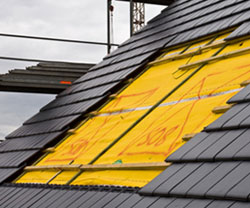Loft Insulation and Ventilation
Many people find the subject of loft insulation and ventilation to be quite confusing. The main reason is because these two goals seem to contradict each other. While it’s natural to feel that insulation and ventilation have opposing goals, proper installation means the two can work in conjunction with each other.
What is Natural Loft Ventilation?
Insulation is added to a loft to hold in warmth. As a result, it seems strange that you would want to use ventilation to bring cold air inside. However, this actually is the right way for insulation and ventilation to work with each other. The two are able to complement each other during both the winter and summer months. When it’s cold outside, the flow of air ensures that snow on the roof doesn’t melt, slide down and then freeze around the gutters. And during hot months, ventilation ensures that hot air doesn’t build up and cause moisture to begin accumulating.
The Right Way to Use Loft Insulation and Ventilation
When it comes to adding insulation and vents to a loft, the most important thing to remember is to avoid allowing insulation to cover soffit vents. If you aren’t familiar with this type of vent, it’s one that can be installed around the eaves of a loft. Soffit vents are commonly made from PVC or aluminum. While these vents are very effective, that won’t be the case if they are covered by insulation. If this occurs, it can reduce their effectiveness to the point where problems with excess heat and moisture accumulation may still be possible.
Another problem that can arise if soffit vents are covered by insulation is an increased energy bill. The reason this can occur is because blocked vents will cause attic fans to function improperly. Instead of drawing in cold air and pushing out hot air, an attic fan will start pulling cold air up from below the loft area. Since this air will be pulled away from where it’s supposed to be, the air conditioner will have to run longer. While the last thing you want to do is pay a higher energy bill, the good news is proper loft insulation and ventilation will prevent this problem from occurring.
Learn What This Job Requires
In order for this job to be properly completed, the process needs to include:
- Insulating material
- Insulation baffles
- Vents

Categories
- Home
- Loft Ventilation Information
- DIY Loft Ventilation
- Loft Insulation and Ventilation
- Loft Ventilating Roof Space
- Loft Ventilation and Condensation
- Loft Ventilation Building Regulations
- Loft Ventilation Costs
- Loft Ventilation Ideas
- Loft Ventilation Installation
- Loft Ventilation Plans
- Loft Ventilation Problems
- Loft Ventilation Tips
- Loft Ventilation Companies
- Loft Ventilation Products
- Types Of Loft Ventilation
